- The Benefits of Growing Large Strawberries Naturally
- Choosing the Right Strawberry Varieties
- Planting Time and Location
- Soil Preparation for Natural Growth
- 1. Choose the right location:
- 2. Test the soil:
- 3. Remove weeds and grass:
- 4. Add organic matter:
- 5. Mulch the bed:
- 6. Water regularly:
- Watering Techniques for Large Strawberries
- 1. Water deeply
- 2. Water in the morning
- 3. Use a drip irrigation system
- 4. Mulch to retain moisture
- 5. Monitor soil moisture
- 6. Adjust watering frequency
- Proper Sunlight Exposure and Shading
- 1. Choosing the Right Location
- 2. Avoiding Excessive Heat
- 3. Using Mulch
- 4. Proper Shading
- 5. Flexible Shading Options
- 6. Regular Monitoring
- Pest and Disease Control Without Chemical Treatments
- Cultural Practices
- Pest Control
- Disease Control
- Harvesting and Storing Juicy Strawberries
- Harvesting:
- Storing:
- Question-answer:
- Can I grow large strawberries without using fertilizers or treatments?
- What are some natural ways to grow large strawberries?
- How important is the soil for growing large strawberries?
- Should I use any specific kind of mulch for growing large strawberries?
- How often should I water my strawberry plants?
- Can I grow large strawberries in containers?
- Are there any specific strawberry varieties that are known for producing large fruits?
- Video: AFTER THIS FERTILIZATION OF STRAWBERRIES, EVEN SEEDLINGS BEGIN TO BEAR FRUIT
Strawberries are a delicious and nutritious fruit that can be enjoyed on their own, added to salads, or used in a variety of culinary creations. However, many store-bought strawberries can be small and lacking in flavor due to the use of fertilizers and treatments. If you’re looking to grow your own strawberries and want them to be large and packed with natural sweetness, here are some tips to help you achieve just that – without the use of chemicals.
1. Choose the right variety
Not all strawberry varieties are created equal when it comes to size and flavor. Look for varieties that are known for producing large berries, such as ‘Ozark Beauty’, ‘Sequoia’, or ‘Earliglow’. These varieties are naturally more inclined to yield larger fruits.
2. Provide ample sunlight
Strawberries thrive in full sunlight, so make sure to choose a location in your garden that receives at least 6 to 8 hours of direct sunlight each day. This will help the plants produce more energy through photosynthesis, resulting in larger and sweeter strawberries.
3. Mulch and compost
Apply a layer of organic mulch, such as straw or wood chips, around the strawberry plants. This will help to conserve moisture, suppress weed growth, and provide a steady supply of nutrients as the mulch breaks down. Additionally, incorporate compost into the soil before planting to improve its fertility and provide a natural source of nutrients.
4. Regular watering
Strawberries have shallow roots and require frequent watering to stay healthy and productive. Aim to keep the soil consistently moist, but not waterlogged. Drip irrigation or soaker hoses are ideal for watering strawberries, as they deliver water directly to the roots and minimize evaporation.
5. Pollinators
Bees and other pollinators are essential for strawberries to develop properly. To attract pollinators, plant some flowers nearby that provide nectar and pollen, such as marigolds, lavender, or wildflowers. Avoid using pesticides or insecticides that can harm pollinators, as this will hinder the fruiting process.
By following these natural methods, you can grow large strawberries that are both delicious and free from harmful chemicals. Enjoy the fruits of your labor and savor the incredible flavor that only homegrown strawberries can provide!
The Benefits of Growing Large Strawberries Naturally
There are several benefits to growing large strawberries naturally, without the use of fertilizers or treatments. Here are some of the key advantages:
- Healthier fruit: By avoiding chemical fertilizers and treatments, you can ensure that your strawberries are free from harmful residues. This means that you can enjoy naturally tastier and healthier fruit.
- Cost-effective: Growing strawberries naturally can be more cost-effective as you won’t need to invest in expensive fertilizers or treatments. This makes it a great option for those on a budget.
- Environmentally friendly: Growing strawberries without the use of chemicals is better for the environment. Chemical fertilizers and treatments can have a negative impact on soil health, water quality, and overall ecosystem balance.
- Sustainable gardening: Natural methods of growing strawberries promote sustainable gardening practices. By building healthy soil, practicing crop rotation, and using organic mulches, you can create a sustainable garden ecosystem that supports the growth of large strawberries year after year.
Overall, growing large strawberries naturally has numerous benefits for both you and the environment. It allows you to enjoy healthier, tastier fruit while also promoting sustainable gardening practices. So why not give it a try and experience the joy of growing your own delicious strawberries?
Choosing the Right Strawberry Varieties
When it comes to growing large strawberries naturally, one of the most important factors to consider is selecting the right strawberry varieties. There are many different types of strawberries available, each with their own unique characteristics and growing requirements. Here are some factors to consider when choosing the right strawberry varieties for your garden:
- Growing Region: Different strawberry varieties are suited for different growing regions. It is important to choose varieties that are known to thrive in your specific climate and conditions. Consult with local gardening experts or extension services to determine which varieties are best for your area.
- Day-Neutral, Everbearing, or June-Bearing: Strawberries are typically categorized into three main types based on their fruiting habits. Day-neutral strawberries produce fruit throughout the growing season, everbearing strawberries produce two to three harvests per year, and June-bearing strawberries produce a single large crop in early summer. Consider which type fits your gardening goals and harvesting preferences.
- Size and Flavor: Some strawberry varieties are known for producing larger fruits, while others have more intense flavors. Consider your personal preference when it comes to fruit size and taste. Keep in mind that larger strawberries may require more care and maintenance.
- Disease Resistance: Certain strawberry varieties are more resistant to common diseases and pests. Choosing disease-resistant varieties can help reduce the need for treatments and ensure healthier plants. Look for varieties that are resistant to gray mold (Botrytis cinerea), powdery mildew, and viruses.
- Runner Production: Some strawberry varieties produce more runners, which are horizontal stems that produce new plants. If you are interested in propagating your strawberries through runners, choose varieties that are known for their prolific runner production.
By considering these factors and doing some research, you can select the right strawberry varieties that will thrive in your garden and produce large, flavorful berries naturally.
Planting Time and Location
When it comes to growing large strawberries naturally, choosing the right time and location for planting is crucial. Here are some factors to consider:
- Time: The ideal time to plant strawberries is in early spring or late fall when the soil is workable. Avoid planting during hot summer months as the heat can stress the plants.
- Location: Select a location that receives full sun for at least 6-8 hours per day. Strawberries thrive in well-drained soil, so make sure the area has good drainage.
- Soil preparation: Prepare the soil by removing any weeds, rocks, or debris. Loosen the soil to a depth of 8-10 inches and mix in organic matter, such as compost or well-rotted manure, to improve fertility and drainage.
- Spacing: Provide enough space between strawberry plants to ensure good air circulation and reduce the risk of diseases. For traditional garden beds, space the plants 12-18 inches apart in rows that are 3-4 feet apart.
- Container planting: If you have limited space, you can also grow strawberries in containers. Choose a large pot or hanging basket with drainage holes and use a high-quality potting mix. Plant one strawberry plant per container.
By considering these factors and taking the time to properly prepare the planting area, you can give your strawberries the best chance to grow into large and healthy plants.
Soil Preparation for Natural Growth
One of the key factors for growing large strawberries naturally is the soil preparation. By creating the right environment for your strawberry plants, you can ensure optimal growth and fruit production without the use of fertilizers or treatments.
1. Choose the right location:
Start by selecting a location for your strawberry bed that gets full sun for at least 6-8 hours a day. Adequate sunlight is essential for the plants to photosynthesize and produce energy for growth. Additionally, ensure that the area has good air circulation to prevent the development of diseases.
2. Test the soil:

Conduct a soil test to determine the pH level and nutrient content of your soil. Strawberries prefer slightly acidic soil with a pH range of 5.5 to 6.5. If your soil is too acidic or alkaline, you can amend it accordingly by adding lime to raise the pH or sulfur to lower the pH.
It is also important to check the nutrient levels of your soil, especially nitrogen, phosphorus, and potassium. This will help you determine if any specific nutrients need to be added to support healthy plant growth.
3. Remove weeds and grass:
Before planting your strawberries, make sure to clear the area of any weeds, grass, or other vegetation. Weeds compete with the strawberry plants for nutrients and resources, which can hinder their growth. Remove them manually or use a hoe or cultivator to cultivate the soil and uproot any existing weeds.
4. Add organic matter:
Improve the soil structure and fertility by adding organic matter such as compost, well-rotted manure, or leaf mold. Organic matter enhances soil drainage, water retention, and nutrient availability for the plants. Spread a layer of organic matter over the soil surface and mix it into the top 6-8 inches of soil using a garden fork or tiller.
5. Mulch the bed:
Apply a layer of organic mulch, such as straw or wood chips, around the strawberry plants. Mulch helps regulate soil temperature, conserves moisture, prevents weed growth, and reduces the likelihood of soilborne diseases. Leave a small gap around the base of each plant to prevent moisture buildup and potential rotting.
6. Water regularly:
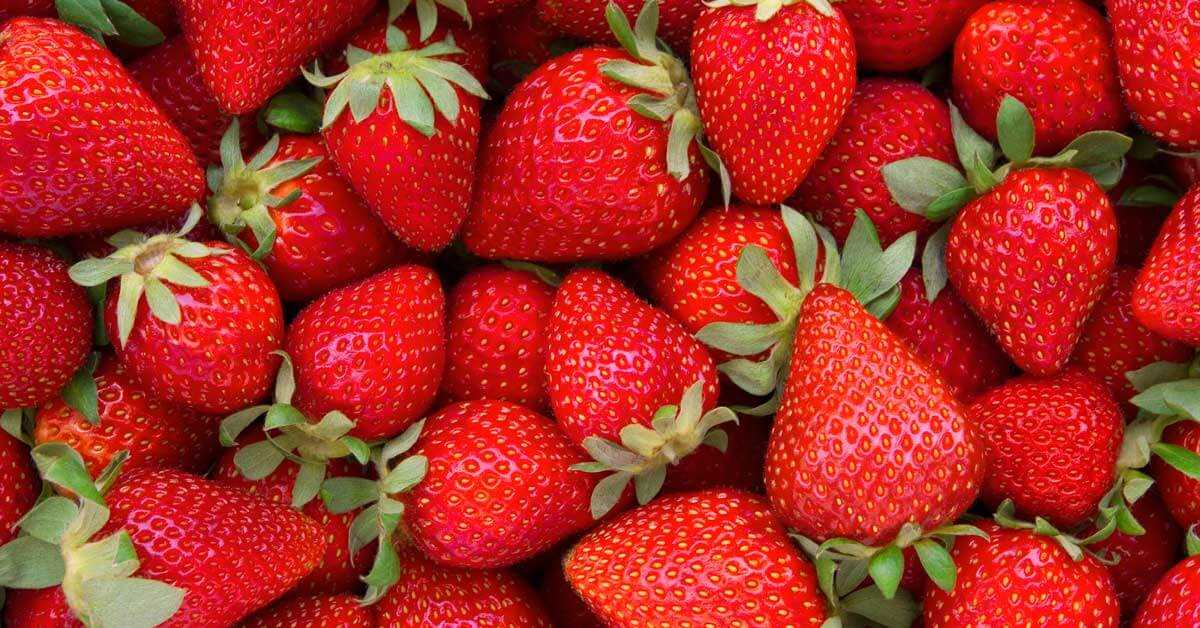
Water your strawberry plants regularly to keep the soil consistently moist but not waterlogged. Give the plants about 1-1.5 inches of water per week, either through rainfall or irrigation. Avoid overhead watering, as wet foliage can promote the development of fungal diseases.
By following these soil preparation steps, you can create an ideal growing environment for your strawberry plants that will promote natural and healthy growth, leading to large and luscious strawberries!
Watering Techniques for Large Strawberries
Proper watering techniques are essential for growing large strawberries naturally. By providing the right amount of water at the right time, you can help your strawberry plants thrive and produce juicy, flavorful fruits. Here are some watering techniques to consider:
1. Water deeply
When watering your strawberry plants, it’s important to water deeply. This means giving them a good soak rather than just lightly sprinkling them. Deep watering encourages the roots to grow deeper into the soil, which helps the plants withstand dry periods and increases their ability to absorb nutrients.
2. Water in the morning
Watering your strawberries in the morning is generally the best time of day. This allows the plants to dry off during the day, reducing the risk of disease and fungal issues. Avoid watering in the evening or at night, as the excess moisture can promote the growth of fungi and other pathogens.
3. Use a drip irrigation system
A drip irrigation system is an efficient way to water strawberry plants. It delivers water directly to the roots, reducing water waste and keeping the foliage dry. This can help prevent common strawberry diseases, such as powdery mildew and gray mold.
4. Mulch to retain moisture
Mulching around your strawberry plants helps retain moisture in the soil, reducing the need for frequent watering. Apply a layer of organic mulch, such as straw or wood chips, around the base of the plants. This will help regulate soil temperature, suppress weeds, and conserve water.
5. Monitor soil moisture
Regularly monitor the moisture level of the soil around your strawberry plants. Stick your finger into the soil and check if it feels dry or moist. If it’s dry, it’s time to water. If it’s moist, hold off on watering for a little longer. Overwatering can cause root rot and other problems, so it’s important to find the right balance.
6. Adjust watering frequency
The watering needs of strawberry plants can vary depending on factors such as weather conditions, soil type, and plant maturity. During hot and dry periods, you may need to water more frequently. As the plants establish and their root systems grow, you may be able to stretch the time between waterings.
By following these watering techniques, you can promote the growth of large, healthy strawberries without the need for fertilizers or treatments. Remember that consistency is key, so aim for a regular watering schedule that suits the needs of your strawberry plants.
Proper Sunlight Exposure and Shading
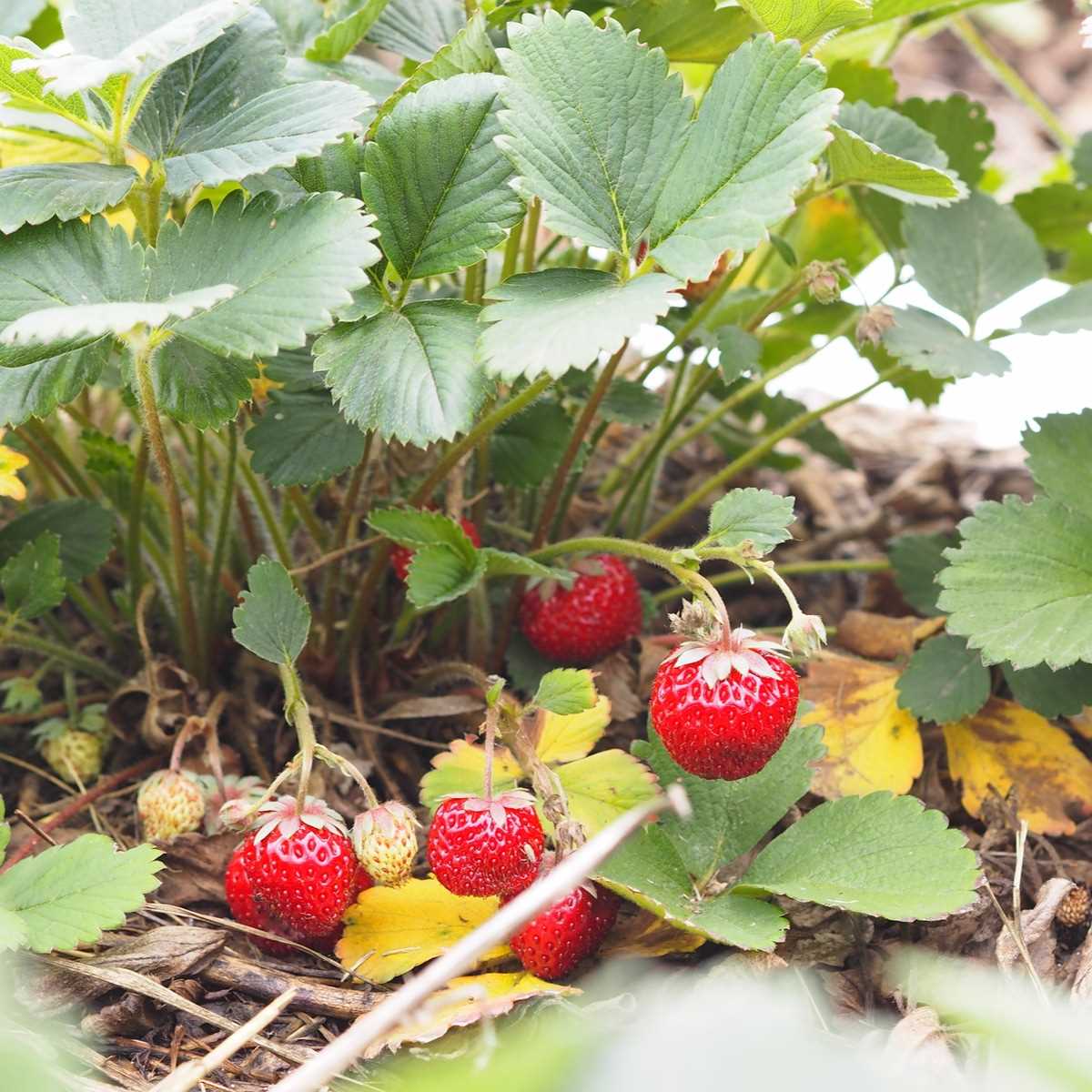
To grow large strawberries naturally, proper sunlight exposure and shading are crucial factors to consider. Strawberries require a good amount of sunlight to thrive, but excessive heat and intense direct sunlight can also be harmful to the plants. Here are some guidelines to follow:
1. Choosing the Right Location
Select a location for your strawberry plants that receives at least 6-8 hours of sunlight per day. This will ensure that your plants get enough light to produce large, sweet berries.
2. Avoiding Excessive Heat
While strawberries love sunlight, they can be sensitive to extreme heat. If your area experiences scorching temperatures, provide some afternoon shade to protect the plants. This can be done using garden fabric, shade cloth, or by planting them near taller plants that can provide natural shade.
3. Using Mulch
Applying a layer of organic mulch around your strawberry plants can help regulate soil temperature and retain moisture. This will prevent the soil from drying out too quickly and protect the roots from excessive heat. Straw, pine needles, or straw-like mulch works well for strawberries.
4. Proper Shading
In addition to avoiding excessive heat, shading can also be beneficial during the fruiting period to prevent sunburn on the berries. You can use shade cloth or build a simple frame with a lightweight fabric cover to provide shading.
5. Flexible Shading Options
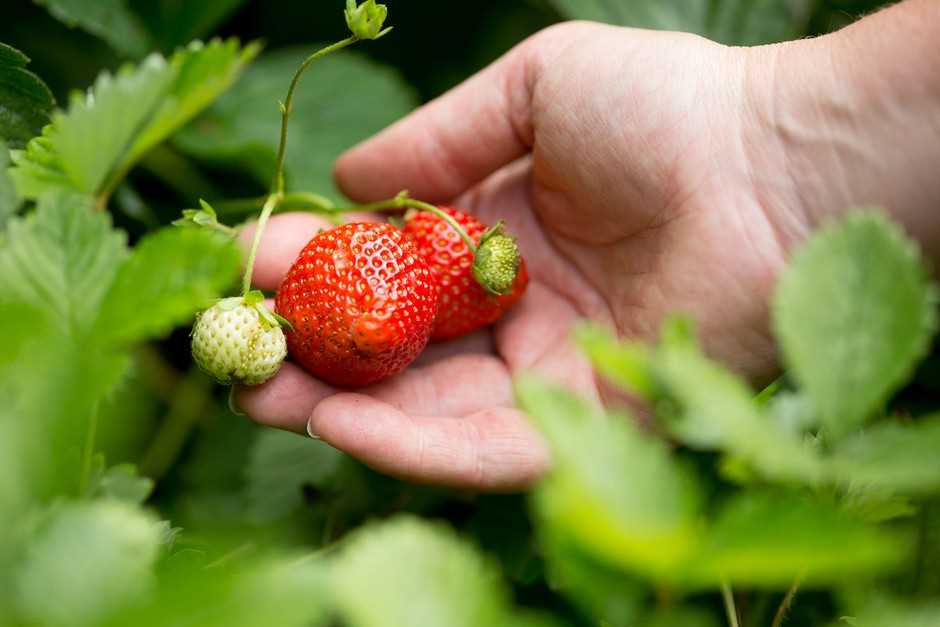
To adapt to changing weather conditions, it’s useful to have shading options that can be easily adjusted. Consider using a movable shade cloth or installing shading structures that can be raised or lowered as needed.
6. Regular Monitoring
Keep an eye on your strawberry plants and adjust the shading as needed. If you notice that the plants are not receiving enough sunlight, you may need to remove or adjust the shading to allow more light in.
By providing the right amount of sunlight exposure and shading, you can create optimal growing conditions for your strawberry plants and help them produce large, delicious berries naturally.
Pest and Disease Control Without Chemical Treatments
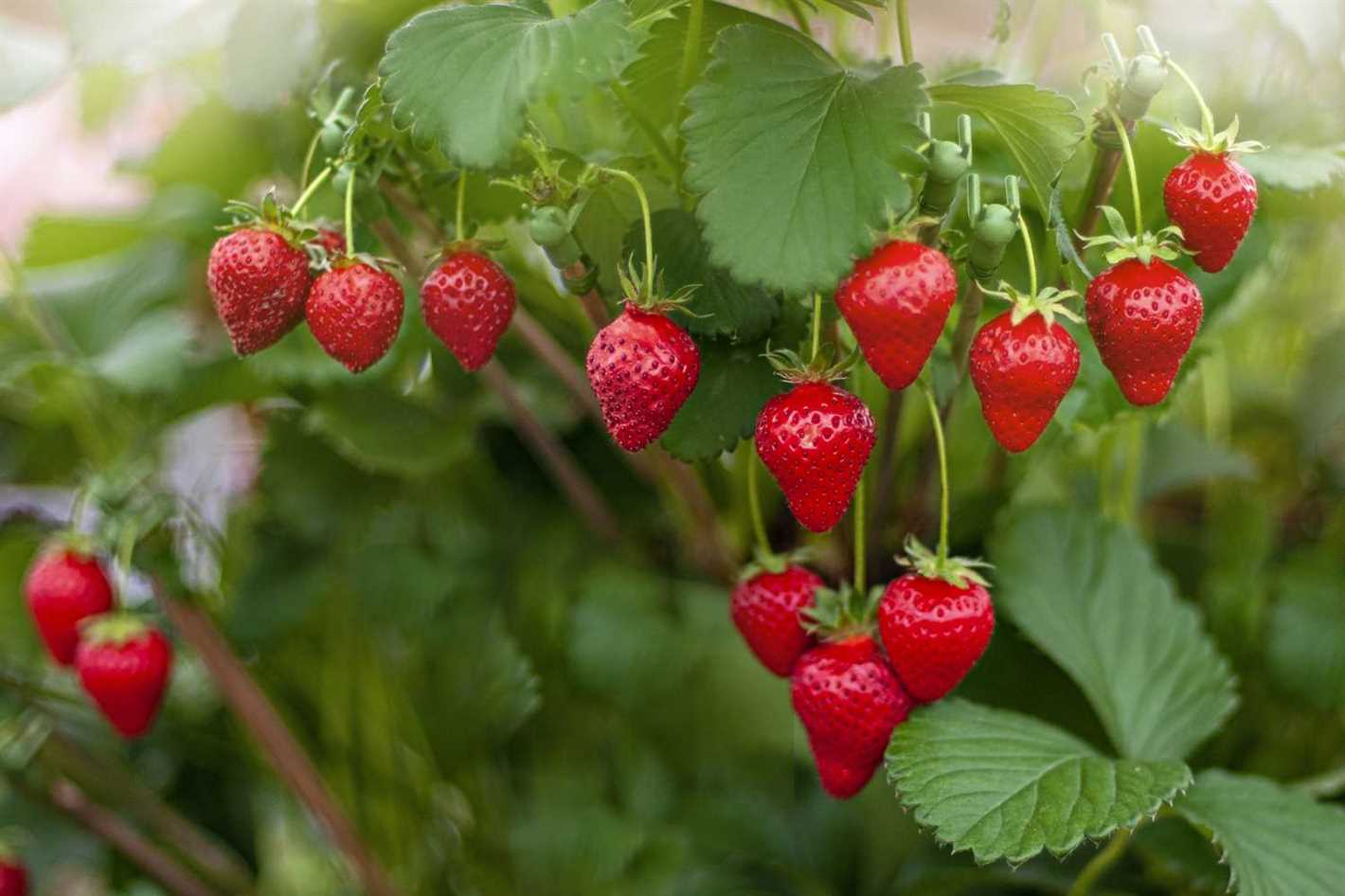
Keeping your strawberry plants healthy and productive doesn’t have to involve the use of chemical treatments. There are natural and organic methods you can employ to control pests and diseases effectively. Here are some tips:
Cultural Practices
- Plant disease-resistant varieties: Choose strawberry varieties that are known to be resistant to common diseases in your area.
- Crop rotation: Avoid planting strawberries in the same area year after year to minimize the buildup of soil-borne diseases. Rotate crops with unrelated plants.
- Healthy soil: Maintain a healthy soil by adding organic matter, such as compost, to improve soil structure and fertility. Healthy plants are less susceptible to diseases and pests.
- Proper spacing: Plant your strawberries with enough space between them to promote good airflow, reducing the chances of diseases spreading.
Pest Control
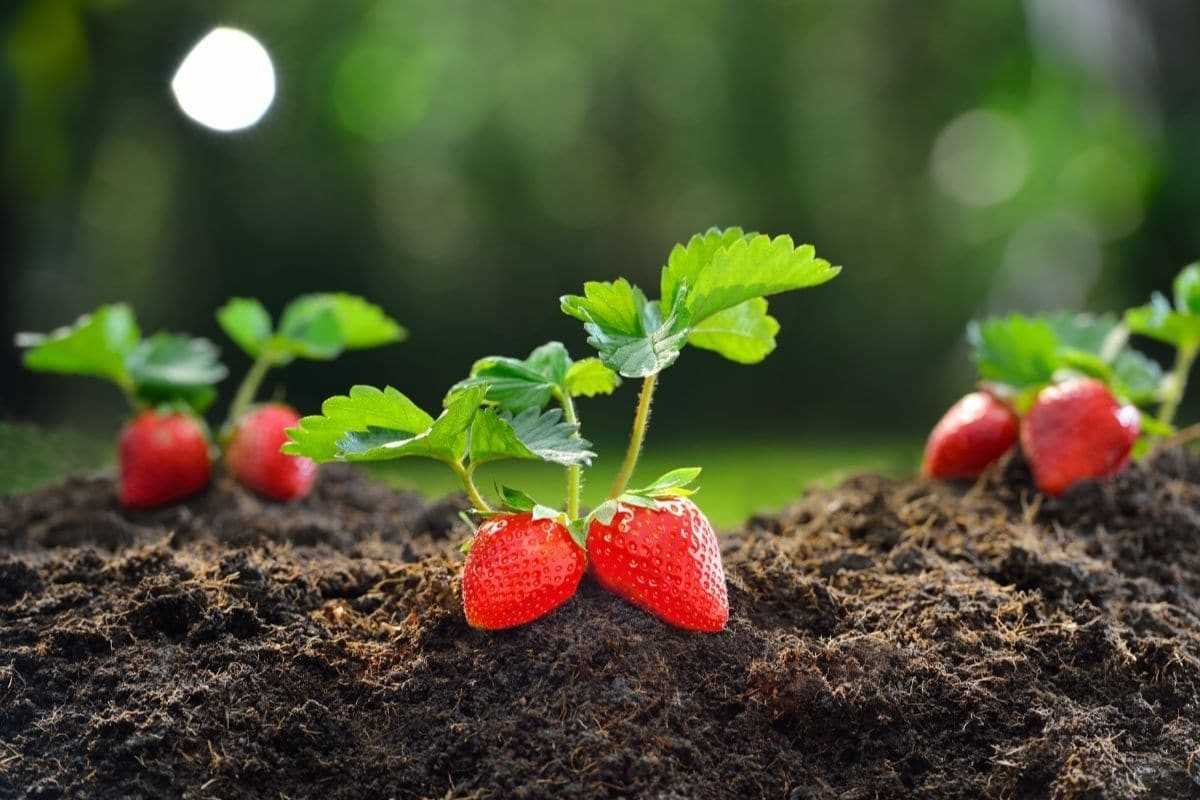
- Manual removal: Inspect your plants regularly and remove any pests you find by hand, such as slugs or snails.
- Barriers: Use physical barriers like netting or row covers to prevent pests, such as birds or insects, from reaching your strawberry plants.
- Beneficial insects: Attract and encourage beneficial insects, like ladybugs and lacewings, which prey on garden pests.
Disease Control
- Proper plant spacing: Allow enough space between your strawberry plants to promote good airflow, which helps to prevent the spread of fungal diseases.
- Avoid overhead watering: Water at the base of the plants to minimize moisture on the foliage, which can lead to fungal infections.
- Remove infected plants: Immediately remove and dispose of any plants showing signs of diseases to prevent the spread.
- Sanitation: Keep your garden clean and free of debris to reduce the chances of diseases overwintering and infecting your strawberry plants.
By implementing these natural pest and disease control methods, you can grow large and healthy strawberries without the need for chemical treatments.
Harvesting and Storing Juicy Strawberries
Harvesting juicy strawberries at the right time and storing them properly is essential to preserve their flavor and quality. Here are some tips on how to harvest and store your strawberries to maximize their freshness:
Harvesting:
- Strawberries are ready to be harvested when they are fully red and have a shiny appearance. Avoid picking them when they are still partially green or white, as they won’t ripen further after being picked.
- To harvest strawberries, firmly hold the stem just above the fruit and gently twist and pull. Be careful not to squeeze or bruise the strawberries while picking them.
- It is recommended to harvest strawberries in the morning when temperatures are cooler. This helps to retain their freshness and flavor.
- Regularly check your strawberry plants for ripe fruits, as strawberries ripen quickly, especially during warmer weather.
Storing:
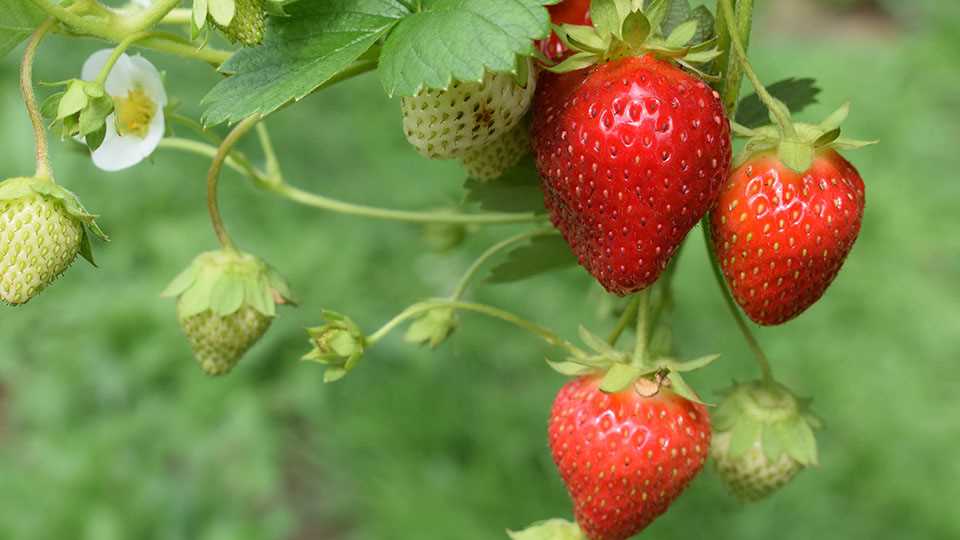
- After harvesting, remove any damaged or overripe strawberries to prevent them from spoiling the entire batch.
- Do not wash the strawberries immediately after picking, as this can promote mold growth and reduce shelf life. Instead, wait until you are ready to consume or use them.
- Store strawberries in a cool and dry place, preferably in the refrigerator. Place them in a shallow container lined with paper towels to absorb excess moisture.
- It is best to consume strawberries within a few days of harvest for optimal flavor. However, if you are unable to consume them all, you can freeze them to extend their shelf life.
By following these harvesting and storing tips, you can enjoy delicious and juicy strawberries even after they have been picked from your garden or purchased from a local market.
Question-answer:
Can I grow large strawberries without using fertilizers or treatments?
Yes, you can! There are natural methods you can use to enhance the growth of strawberries without relying on fertilizers or treatments.
What are some natural ways to grow large strawberries?
Some natural ways to grow large strawberries include planting them in well-drained soil, providing adequate sunlight, regular watering, and using organic mulch.
How important is the soil for growing large strawberries?
The soil plays a crucial role in growing large strawberries. They prefer well-drained soil that is rich in organic matter and has a pH level between 5.5 and 6.8. It is recommended to amend the soil with compost or aged manure before planting.
Should I use any specific kind of mulch for growing large strawberries?
Using organic mulch, such as straw or wood chips, is beneficial for growing large strawberries. It helps to retain moisture, suppress weeds, and regulate soil temperature.
How often should I water my strawberry plants?
Strawberry plants require regular watering, especially during dry periods. It is important to keep the soil evenly moist, but not waterlogged. Watering frequency will depend on the weather conditions and the type of soil you have.
Can I grow large strawberries in containers?
Yes, you can grow large strawberries in containers. Choose a container that has drainage holes and fill it with well-drained soil. Make sure the container receives adequate sunlight, and water the plants regularly.
Are there any specific strawberry varieties that are known for producing large fruits?
Yes, there are strawberry varieties known for producing large fruits. Some popular ones include ‘Chandler’, ‘Seascape’, ‘Tristar’, and ‘Albion’. These varieties are known for their size, flavor, and productivity.







